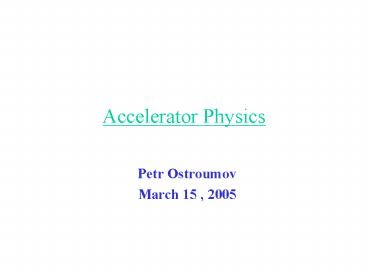Accelerator Physics - PowerPoint PPT Presentation
1 / 21
Title:
Accelerator Physics
Description:
Basic concepts for the Linac design. Choice of lattice parameters ... inside the separatrix. March 15-17, 2005. Proton Driver Director's Review. 9. Fermilab ... – PowerPoint PPT presentation
Number of Views:58
Avg rating:3.0/5.0
Title: Accelerator Physics
1
Accelerator Physics
- Petr Ostroumov
- March 15 , 2005
2
Outline
- Basic concepts for the Linac design
- Choice of lattice parameters
- High-intensity beam physics
- Detailed design and simulations
- RD issues
- Conclusion
3
8-GeV Linac conceptual design
- GOAL Design 8-GeV high-power linac in a
cost-effective manner - Apply TESLA cavities above 1.2 GeV
- Feed multiple cavities from one klystron
- Develop and use S-TESLA cavities (beta0.83) in
the energy range 400 MeV-1.2 GeV - Select sub-harmonic frequency for the front end
1/4. Motivation multi-spoke cavities are
developed at 345-350 MHz. Requires 30 less
number of cavities compared to 433 MHz option.
Klystrons are available from JHF developments. - No need in SRF cavities below 15 MeV use 21
RT-TSR with very high shunt impedance. Power
distribution is similar to those for SRF cavities
4
Linac conceptual design (contd)
- 325 MHz SSR, DSR and TSR from 15 MeV to 400 MeV
- Apply SC solenoid focusing to obtain compact
lattice in the front end including MEBT - JHF-SNS-style RFQ delivers axial-symmetric 3 MeV
beam - MEBT consists of 2 re-bucnhers and a chopper.
Smooth axial-symmetric focusing mitigates beam
halo formation - Beam matching between the cryostats adjust
parameters of outermost elements (solenoid
fields, rf phase) - Frequency transition 14 at 400 MeV, matching in
(?, ?W)-plane is provided by 90? bunch rotation
- Avoid beam losses due to H-minus stripping
5
Linac Structure
Major Linac Sections Front end Squeezed
TESLA TESLA
325 MHz 1300 MHz 1300 MHz
6
RT-TSR
Shunt Impedance 160 M?/m - 80 M?/m
7
Energy gain per resonator vs distance
8
Stability Diagram (transverse motion)
Unstable due to parametric resonance
Stable for all particles inside the separatrix
9
Defocusing Factor vs Energy
Defocusing factor
S-TESLA 6 cavities/period TESLA 16
cavities/period
S-TESLA 4 cavities/period TESLA 8
cavities/period
Beam Energy (MeV)
10
Focusing lattice
11
High intensity beam physics
- Current independent lattice (Developed at LANL
for ATP, SNS ) - Smooth kT0 and kL0 avoid jumps in the
transition, very important in the SC linac - Space charge and higher order internal resonances
- Beam matching in the transitions
- Parameters should be close to equpartitioning
- Avoid obvious resonance ?T0 90?
- Watch for higher order resonances (Hoffmans
Chart) - Final verification by multi-particle simulations
- Front End
- The length of focusing period should be
minimized SC solenoids provide shortest focusing
period - Analyze HOM and excessive avoid power losses on
cavity walls
12
RMS analysis wavenumebrs of T- and L-oscillations
13
RMS analysis Phase advance
14
Detailed design and simulation
- RFQ design
- Linac design on the base of rms equations (TRACE
3D, TRACK-fitting) - Simulations with the codes PARMILA, IMPACT and
TRACK - End-to-end simulations TRACK
- All fields are 3-D, resonators fields - MWS,
solenoid fields - EMS - Most time-consuming work is beam matching in the
transitions between different sections and
cryostats
15
End-to-end BD simulations (20K particles)
Beam current 30 mA-RFQ, 28 mA - Linac
aperture
16
Phase width (deg) along the linac
Beam current 30 mA-RFQ, 28 mA - Linac
17
The same tune, 10 mA, 0 mA
10 mA-RFQ entrance Zero current
18
Emittance growth
Main reason of the emittance growth in current
design beam mismatch. This effect can be avoided
by careful tuning.
30 mA (28 mA)
10 mA (9.3 mA)
19
Phase space plots of 8 GeV beam
20
RD issues
- Develop optimized design of the linac
- Error studies
- Study of different options of the linac to
provide the most cost-effective design. - Example frequency transition energy (110 MeV vs
400 MeV) - Detailed studies of HOM in all TESLA cavities and
in TSRs - Iterate beam dynamics studies with hardware
development - Some code development work is required
- fitting in realistic fields
- support many different types of lattice structure
- include feedback loops of rf field for error
simulations - Apply different codes for BD simulations
- High-statistics simulations
21
CONCLUSIONS
- Beam physics in the driver is predictable. Most
problems are similar to the SNS and can be solved
during RD phase - New approach in hadron Linacs - Pulsed SC Front
End-provides high-quality beams - The concept of current-independent tune similar
to those developed for the SNS works well for the
Proton Driver - RD work is required to eliminate uncertainties
and provide cost-effective design and
construction of the Linac


















![Modern Physics [2] PowerPoint PPT Presentation](https://s3.amazonaws.com/images.powershow.com/8002705.th0.jpg?_=20160723081)











![L 35 Modern Physics [1] PowerPoint PPT Presentation](https://s3.amazonaws.com/images.powershow.com/7552279.th0.jpg?_=20160119094)
